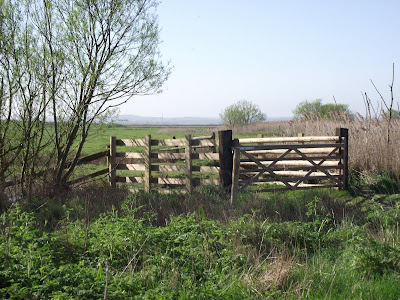"It all seemed too good to be true. Hither and thither through the meadows he rambled busily, along the hedgerows, across the copses, finding everywhere birds building, flowers budding, leaves thrusting - everything happy, and progressive, and occupied. And instead of having an uneasy conscience pricking him and whispering "Whitewash" he somehow could only feel how jolly it was to be the only idle dog among all these busy citizens. After all, the best part of a holiday is perhaps not so much to be resting yourself, as to see all the other fellows busy working."
Perhaps these photos, to people used to the packed-in colour of woods and hedgerows, will seem a bit featureless but the marsh has just as much going on, it just doesn't look like it unless you're there to see and hear it. If you double click on each photo and enlarge you will see that there is often quite different scenery in the background.
This first one is the start of the walk, looking over the five-bar gate from the barn.

All round the barn are many. many willow trees and bushes of different shapes and sizes and all have been started over the years by me by simply pushing into the ditch sides, small branches broken from the trees. These ones are the latest addition, pushed in just two winters ago.

Stepping through the gate you get this view looking west across the flatness of the marsh. The bushes and reedbeds to the right are part of the neighbouring farmland.

Having walked across the marsh and climbed up on to the seawall you come across large clumps of this wildflower called Alexanders. Not one likely to feature in too many people's snapshots of wildflowers because of it's lack of pretty flowers but in late March it grows at an incredible rate and makes around three feet in just a couple of weeks. Its pale, fluffy flowers are quite attractive to insects when they first open.

This view looks across the field that we know as "The Flood" and in the background you can see the Tower Hide and further behind, the holiday camps of Leysdown.

Another view, over the Delph reedbeds and onto the flat marsh, now recovered from the winter flooding.

The view west along the seawall, with The Swale in the distance and behind that is Oare nature reserve and Harty on the mainland side.
Amazingly, while I was taking this photo, I had a pair of Bearded Tits calling in the reedbed to the right and three Med. Gulls gliding by along the saltings to the left.

Looking east, compare this photo taken in January to the one after of the same view taken this morning.


Part way along the seawall you come to the Delph Fleet crossing, which allows you access onto the reserve.

Standing on the crossing, this is the view east down The Delph. You can see the top of the Sea Wall hide in the background. Soon these reed beds will be a riot of green growth and echoing to the sound of Reed and Sedge Warblers.

Immediately over the crossing you are into the field of Emmitt Casts, or ant hills, which these two Greylags were wandering through, grazing as they went.

A poor photo of a distant Shelduck.

As the reserve starts to dry out after the winter floods, these small splashes of water and soft mud are left behing for a while. They attract large numbers of flies and beetles and are a vital piece of habitat for Lapwing and Redshank chicks as they begin to hatch out and move around.

This swan was quite happily slowly moving down the ditch, paddling with just the one leg and resting the other.

And so back to the barn with its surround of willows bushes and home.

Thanks Derek, what a good idea. I really enjoyed this post. It must be wonderful to see the trees that you planted grow each year.
ReplyDeleteKieron,
ReplyDeleteWillows are so easy to get going, simply break off a branch from an established tree and push it into wet soil in the winter and hey presto, it grows.
An enjoyable post Derek and good to see the contrast from January, I'm sure I know which view you prefer!
ReplyDeleteLovely swan photo.